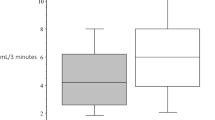Abstract
Our objective was to investigate the putative role of epidermal growth factor (EGF) in esophagitis pathogenesis in both nondrinkers and chronic alcoholics. We studied the EGF serum level, the EGF salivary concentration, and the esophageal EGF receptor expression in different groups of patients with esophagitis: nondrinkers with typical symptoms of gastroesophageal reflux (N=12) and chronic alcoholics (N=12), and in controls: chronic alcoholics without esophagitis (N=16) and healthy nondrinkers (N=12). All patients had an endoscopy with esophageal biopsies, 24-hr esophageal pH-metry, and esophageal manometry. EGF serum levels and EGF salivary concentrations were determined by radioimmunoassay. EGF receptor expression was determined by immunohistochemistry. Both the EGF serum level and the EGF salivary concentration remained constant, 328±21 pg/ml and 305±48 pg/ml, respectively, regardless of alcohol intake and the presence or absence of esophagitis. In addition, the presence of esophagitis did not affect the EGF receptor expression. These results suggest that seric and salivary EGF is not involved in the pathogenesis of reflux esophagitis in nondrinkers and in chronic alcoholics.
Similar content being viewed by others
References
Marti U, Burwen SJ, Jones AL: Biological effects of epidermal growth factor with emphasis on the gastrointestinal tract an liver: An update. Hepatology 9:126–138, 1989
Barnard JA, Beauchamp RD, Russell WE, Dubois RN, Coffey RJ: Epidermal growth factor-related peptides and their relevance to gastrointestinal physiology. Gastroenterology 108:564–580, 1995
Bans-Schlegel SP, Quintero J: Human oesophageal carcinoma cells have fewer, but higher affinity epidermal growth factor receptors. J Biol Chem 261:4359–4362, 1986
Dutta SK, Meirowitz RF, Vengurlekar S, Resau J: Localization and characterization of epidermal growth factor receptors in human oesophageal epithelium. Gastroenterology 98:A38, 1990
Jankowski J, Murphy S, Coghill G, Grant A, Hopwood D, Wormsley KG: Expression of epidermal growth factor receptors in oesophageal mucosa. Gut 33:439–443, 1992
Scheving LA, Yeh YC, Tsai TH: Circadian phase-dependent stimulation effects of epidermal growth factor on DNA synthesis in the tongue, oesophagus and stomach of the adult male mouse. Endocrinology 106:1498–1503, 1980
Brown RD, Vengulekar RD, Dutta SK: Salivary and recombinant human epidermal growth factor induce cellular proliferation in human esophageal epithelial cells. Gastroenterology 100:A998, 1991
Gray MR, Donnely RJ, Kingsnorth AN: Role of salivary epidermal growth factor in the pathogenesis of Barrett's columnar lined oesophagus. Br J Surg 78:1461–1466, 1991
Tuchman DN, Dutta SK, Vengurlekar SM, Gottal R, Bidani JA, Dutta D: Reduction in salivary epidermal growth factor secretion an alteration in EGF receptor expression in oesophageal mucosa in pediatric patients with reflux oesophagitis. Gastroenterology 102:A182, 1992
Rourk RM, Yu Z, Namiot Z, Sarosiek J, McCallum RW: Esophago-salivary reflex impairment as the potential cause of diminished salivary epidermal growth factor secretion in patients with reflux oesophagitis. Gastroenterology 104:A2455, 1993
Gunder SA, Dutta SK, Schreiber JS, Vengurlekar SM, Papadimitriou JC, Resau JH: Increased expression of epidermal growth factor receptor in reflux oesophagitis. Gastroenterology 100:A1772, 1991
Jankowski J, Coghill G, Tregaskis B, Hopwood D, Wormsley KG: Epidermal growth factor in the oesophagus. Gut 33:1448–1453, 1992
Banciu T, Sorian E: Gastroesophageal reflux in chronics alcoholics. Med Intern 27:279–282, 1989
Dutta SK, Dukehart M, Narang A, Latham PS: Functional and structural changes in parotid glands of alcoholic cirrhotic patients. Gastroenterology 96:510–518, 1989
Durr HK, Bode JC, Figarella C, Sarles H: Does chronic intake of alcohol cause changes in the secretory pattern of the parotid gland?In Alcohol and the Gastrointestinal Tract. Les colloques de l'INSERM (ed) Paris, INSERM, 1980, 95:257–262.
Ozawa S, Ueda M, Ando N, Abe N, Shimizu N: High incidence of EGF receptor hyperproduction in oesophageal squamous-cell carcinoma. Int J Cancer 39:333–337, 1987
Dutta SK, Matossian HB, Meirowitz RF, Vaeth J: Modulation of salivary secretion by acid infusion in the distal esophagus in humans. Gastroenterology 103:1833–1841, 1992
Keshavarzian A, Iber FL, Ferguson Y: Esophageal manometry and radionuclide emptying in chronic alcoholics. Gastroenterology 92:651–657, 1987
Rourk RM, Yu Z, Namiot Z, Sarosiek J, McCallum RW: Secretory impairment of esophageal epidermal growth factor as a potential link leading to the development of reflux oesophagitis. Gastroenterology 104:A1165, 1993
Author information
Authors and Affiliations
Rights and permissions
About this article
Cite this article
Benamouzig, R., Ferrière, F., Guettier, C. et al. Role of salivary and seric epidermal growth factor in pathogenesis of reflux esophagitis in chronic alcoholics and nondrinkers. Digest Dis Sci 41, 1595–1599 (1996). https://doi.org/10.1007/BF02087906
Received:
Accepted:
Issue Date:
DOI: https://doi.org/10.1007/BF02087906




